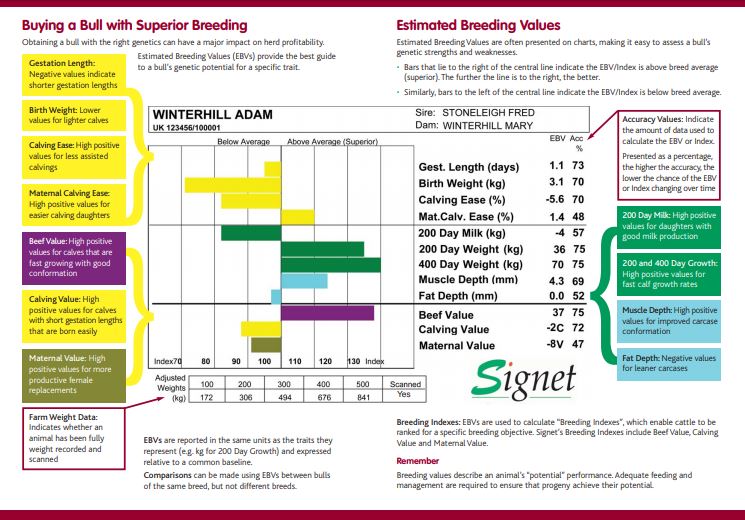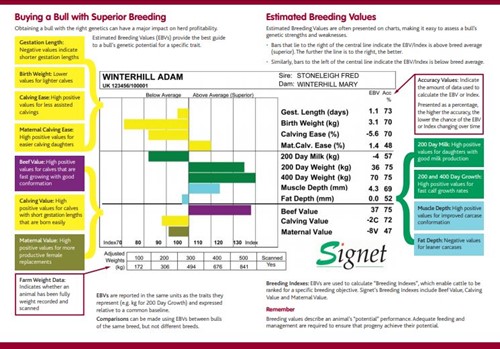Interpreting EBVs and Indexes

Interpreting Estimated Breeding Values
Estimated Breeding Values (EBVs) provide a measure of the breeding potential of an animal for a specific trait. They take into account performance data collected on known relatives, the relationships between performance traits (correlations) and the degree to which traits are inherited from one generation to the next (heritabilities).
EBVs are expressed in the same units as the recorded trait (e.g. kg for 200-day weight) and they relate to a common baseline (usually set in 1980).
EBVs are easy to interpret, for example:
A bull with an EBV of +40 for 400-day weight is estimated to have progeny with the genetic potential to be 20kg heavier at 400 days of age compared to a bull with an EBV of 0.
A recorded bull will only pass on half of its genes to its calves so its EBVs must be halved in order to estimate the average genetic worth of its progeny.
Information is often presented in a bar chart format, with bars to the right indicating superior animals, those to the left indicating those with genetic merit below breed average.
Estimated Breeding Values
Pedigree and performance data is analysed to calculate how much of each animal’s performance is due to its breeding merit and how much is due to the environment in which it has been raised. This assessment of breeding potential is expressed as Estimated Breeding Values or EBVs.
The following EBVs are produced for Signet clients:
| EBV | Interpretation | Notes |
| Birthweight (kg) | Negative values = lighter calves at birth | High birth weights are more likely to be associated with difficult calvings |
| Gestation length (days) |
Negative values = shorter gestations | Short gestation lengths result in easier calvings, because birthweights tend to be lower. A short gestation also increases the interval between calving and the start of mating, giving the cow more time to recover body condition. |
| Calving ease (direct) (%) | Positive values = more unassisted calvings | Estimates the percentage of unassisted calvings that can be derived from a particular sire. |
| 200-day growth (kg) | Positive values = faster growth rates | Selection for faster growth will result in animals that have heavier carcases at a constant fat class or leaner carcases at a constant age. Selection for high growth rates also tends to result in an overall increase in mature size (and therefore higher birthweights). |
| 400-day growth (kg) | Positive values = faster growth rates | |
| Muscle depth (mm) | Positive values = deeper loin muscles | Selecting for these traits will increase the yield of lean meat in the carcase. |
| Backfat depth (mm) | Negative values = leaner carcases | Indicates animals capable of producing lean carcases or, if required, can be taken to heavier carcase weights without becoming overfat. |
| EBV | Interpretation | Notes |
| Longevity (days) | Positive values = longer breeding life | Predicts the length of an animal’s breeding life in the herd. |
| Age at 1st calving (days) | Negative values = puberty reached at an early age | Herds looking to calve heifers at two years of age should identify bulls with superior (negative) EBVs for this trait. This will increase conception rates at first mating. |
| Calving interval (days) | Negative values = cows that get back in calf more quickly | This EBV can be used to breed cows with short calving intervals that get in calf again quickly. |
| 200-day milk (kg) | Positive values = more productive female replacements | This EBV is the maternal component of 200-day weight. It indicates how well a bull’s heifer calves will perform when they become mothers and is greatly influenced by milking ability. |
| Maternal calving ease (%) | Positive values = more unassisted calvings | Identifies females that will calve more easily. Should not be confused with calving ease direct (see above), which is an EBV predicting how easily born a bull’s progeny will be. |
What is a Breeding Index?
While EBVs aid the selection of breeding stock according to specific traits they can also be combined into selection indexes to meet wider breeding objectives.
An index is an overall score of genetic merit combining the relative economic values of several EBV traits. Signet offers five selection indexes:
- Beef value: The economic value of an animal in terms of the financial merit of its offsprings’ carcases
- Calving value: The economic value of an animal in terms of gestation length and difficult calvings
- Maternal value: The economic value of an animal’s genetic ability to produce breeding females
- Maintenance value: The economic cost associated with mature size
- Maternal production value: The economic value of an animal in terms of its genetic potential to produce females for breeding and animals with beef carcase characteristics, calculated from the four sub-indexes listed above.
The EBVs accounted-for in the calculation of these indexes is shown below:
Indexes cannot be compared between breeds. To avoid confusion, Index values are sometimes prefixed with two letters which indicate which breeder they refer to, e.g. LM for Limousin
When using a Breeding Index it is important that your breeding objective is broadly similar to that of the Index in question, otherwise you may unwittingly change aspects of your herd that you did not necessarily want to.

